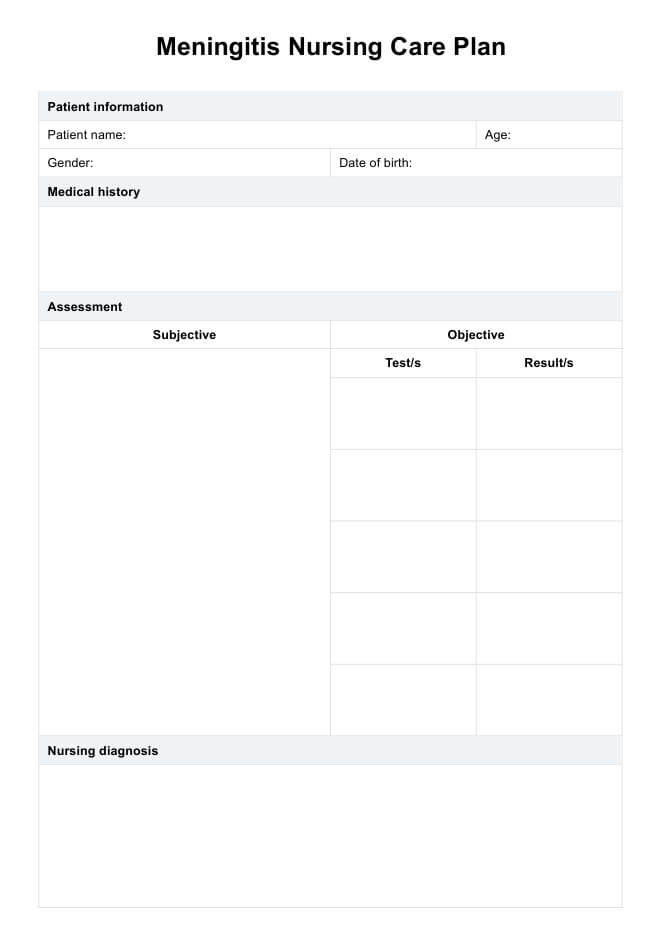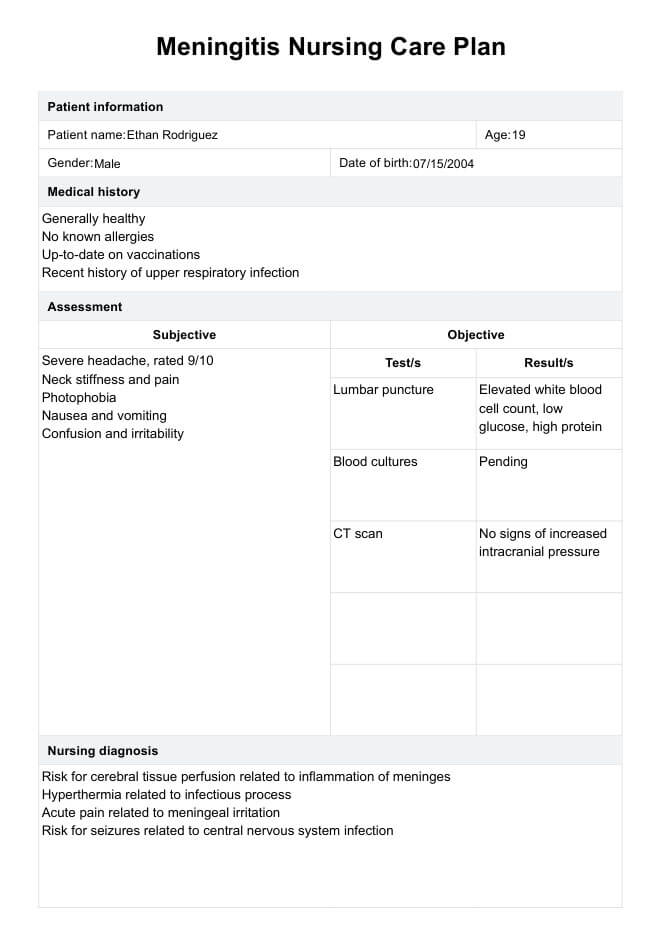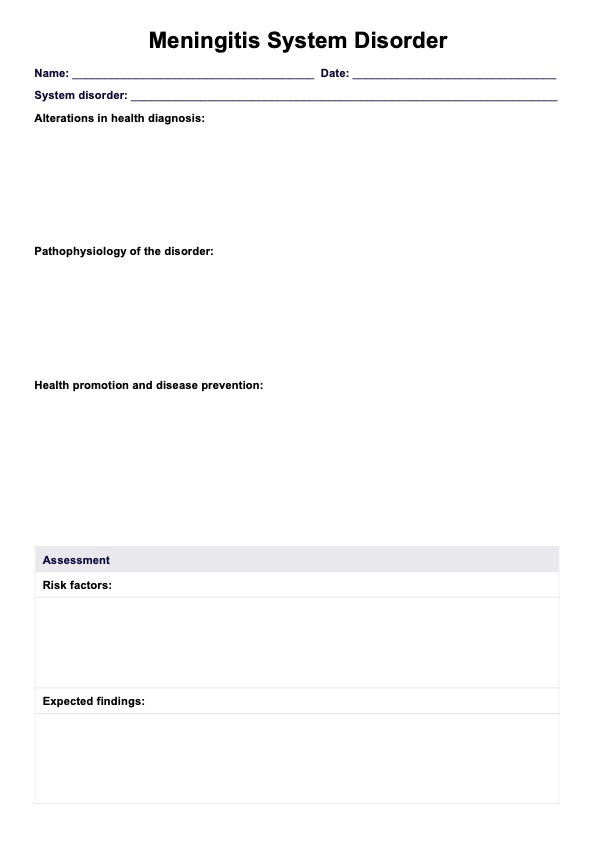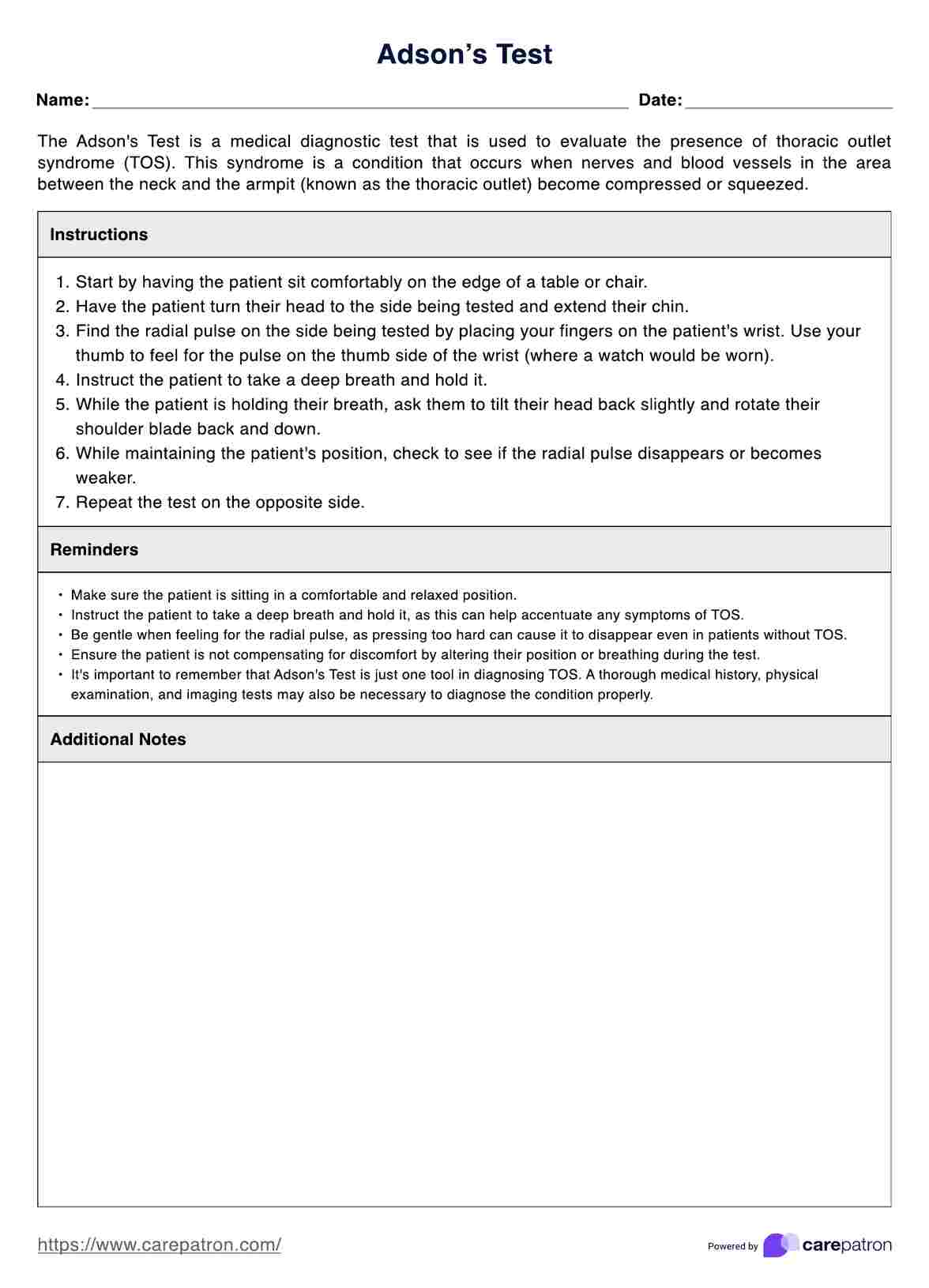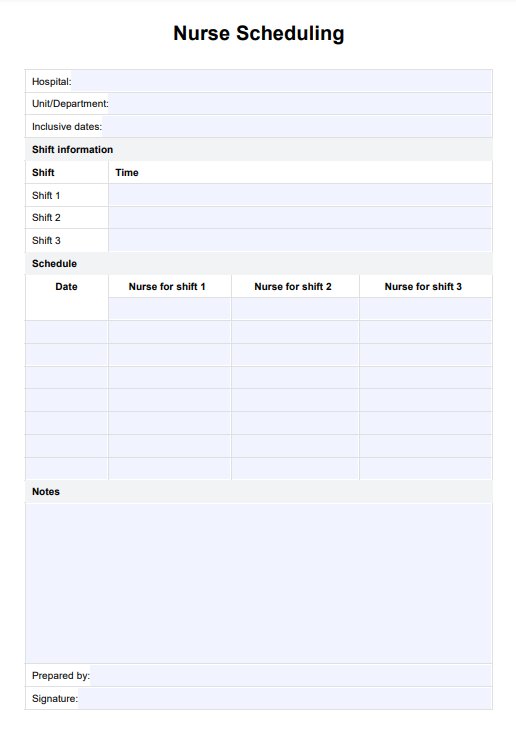Meningitis Nursing Care Plan
Access Carepatron's free PDF download of a Meningitis Nursing Care Plan and example to help with a nursing diagnosis for meningitis. Learn how to create an effective care plan for patients with meningitis.


What is meningitis?
Meningitis is a serious condition characterized by inflammation of the protective membranes covering the brain and spinal cord, known as the meninges. One of the signs and symptoms is inflammation, which is often triggered by bacterial or viral infections, particularly severe meningitis.
Swift diagnosis and treatment are crucial in bacterial meningitis, such as acute bacterial meningitis. Bacterial strains like pneumococcal meningitis and meningococcal meningitis caused by Neisseria meningitides are a significant concern due to their rapid onset and potential for complications. Viral meningitis, while generally less severe, also requires prompt medical attention.
Nurses then play a pivotal role in recognizing symptoms early on. This could include altered mental status, meningeal irritation (manifested as neck stiffness), and elevated vital signs. Timely intervention involves antibiotic therapy to combat the infection and monitoring for signs of cerebral edema and elevated intracranial pressure.
Diagnostic procedures like lumbar puncture analyze cerebrospinal fluid, which crosses the blood-brain barrier to detect signs of infection. Nursing management revolves around relieving acute pain, managing symptoms, and closely monitoring the patient's condition for any signs of deterioration.
Signs and symptoms of meningitis
Meningitis can present with various symptoms, some of which may overlap with other illnesses. Prompt recognition of these signs is vital for early diagnosis and treatment. Here are the key signs and symptoms to watch for:
- Sudden onset of high fever
- Severe headache
- Stiff neck, especially when trying to touch the chin to the chest
- Nausea and vomiting
- Sensitivity to light (photophobia)
- Altered mental status, confusion, or difficulty concentrating
- Skin rash (in the case of meningococcal meningitis)
- Convulsions or seizures
- In infants, symptoms may also include irritability, poor feeding, and a bulging fontanelle (soft spot on the baby's head)
Types of meningitis
Meningitis can be caused by different pathogens, leading to distinct types of the condition. Understanding these variations is essential for appropriate diagnosis and treatment. Here are the main types of meningitis:
- Bacterial meningitis: Caused by bacteria, such as Streptococcus pneumoniae, Neisseria meningitidis (meningococcus), and Haemophilus influenzae type b (Hib).
- Viral meningitis: Caused by enteroviruses, herpes simplex virus, and influenza viruses.
- Fungal meningitis: Caused by fungal infections, such as Cryptococcus neoformans and Histoplasma capsulatum.
- Parasitic meningitis: Rare but can occur due to parasitic infections, such as those caused by Naegleria fowleri or Angiostrongylus cantonensis.
Each type of meningitis has its own set of symptoms, risk factors, and treatment approaches.
Causes of meningitis
Meningitis can stem from various factors, including infectious agents and non-infectious triggers. Understanding the underlying causes is crucial for effective management and prevention. Here are the primary causes of meningitis:
- Bacteria: Streptococcus pneumoniae, Neisseria meningitidis, Haemophilus influenzae, and Listeria monocytogenes are common bacterial culprits.
- Viruses: Enteroviruses, herpes simplex virus, and mumps virus are frequent viral causes.
- Fungi: Cryptococcus neoformans and Histoplasma capsulatum are fungal pathogens associated with meningitis.
- Parasites: Rarely, parasites like Naegleria fowleri or Angiostrongylus cantonensis can cause meningitis.
- Autoimmune disorders: Conditions like lupus and Behçet's disease can trigger autoimmune reactions leading to meningitis.
- Medications: Certain drugs, such as nonsteroidal anti-inflammatory drugs (NSAIDs) and antibiotics, may rarely cause aseptic meningitis as a side effect.
- Trauma: Head injuries or surgical procedures involving the brain or spinal cord can sometimes result in meningitis.
Complications meningitis may lead to
Meningitis can lead to various complications, ranging from mild to severe, depending on factors such as the underlying cause, timeliness of treatment, and individual health status. Understanding these potential complications is crucial for both healthcare providers and patients. Here are the main complications meningitis may lead to:
- Brain damage: Severe cases of meningitis can result in inflammation and damage to the brain tissue, leading to cognitive deficits, memory problems, and other neurological impairments.
- Hearing loss: Meningitis can cause damage to the structures of the inner ear, resulting in partial or complete hearing loss. This complication is more common in bacterial meningitis, particularly in children.
- Vision problems: Inflammation of the optic nerve or damage to the brain's visual processing centers can lead to vision disturbances or even permanent vision loss.
- Hydrocephalus: Meningitis can disrupt the normal flow of cerebrospinal fluid (CSF) within the brain, leading to a buildup of fluid and increased pressure inside the skull. This condition, known as hydrocephalus, may require surgical intervention to alleviate pressure.
- Seizures: Some individuals may experience seizures due to meningitis, mainly if there is significant irritation or damage to the brain tissue.
- Septic shock: Bacterial meningitis, mainly when caused by certain aggressive strains, can lead to septic shock—a life-threatening condition characterized by a severe drop in blood pressure and organ failure.
Meningitis Nursing Care Plan Template
Meningitis Nursing Care Plan Example
How to use our nursing care plan for meningitis PDF?
Carepatron's Meningitis Nursing Care Plan Template is a valuable tool for healthcare practitioners involved in the care of patients with meningitis. This comprehensive template streamlines the process of developing individualized care plans tailored to each patient's specific needs. Here's a step-by-step guide on how to utilize our template effectively:
Assessment
Before utilizing the template, thoroughly assess the patient's condition, including reviewing their medical history, current symptoms, and diagnostic results. This assessment forms the foundation for developing a personalized care plan.
Identification of nursing diagnoses
Utilize the template to identify nursing diagnoses relevant to the patient's meningitis condition. This may include diagnoses such as "risk for infection related to compromised immune system," "acute pain related to inflammation of meninges," or "impaired cognition related to amended mental status."
Goal setting
Set specific, measurable, achievable, relevant, and time-bound (SMART) goals for each nursing diagnosis identified. Goals should be focused on improving the patient's condition, managing symptoms, and preventing complications. Use the template to document these goals and outcomes clearly.
Intervention planning
Based on the identified nursing diagnoses and goals, develop a comprehensive plan of nursing interventions using the template. This may include actions such as administering antibiotics as prescribed, monitoring vital signs regularly, providing comfort measures for pain relief, and educating the patient and their family about the condition and its management.
Rationale
Explain the scientific or theoretical basis for each intervention, linking nursing actions to expected patient outcomes. This supports continuity of care by allowing other healthcare providers to understand the reasoning behind the chosen interventions.
Implementation
Implement the nurse interventions outlined in the care plan consistently and according to the patient's needs. Document the implementation of each intervention, including the date, time, and any relevant observations or outcomes.
Evaluation
Evaluate the effectiveness of the nurse interventions and the progress towards achieving the established goals regularly. Use the template to record the patient's response to treatment, any changes in their condition, and necessary adjustments to the care plan.
How nurses assess and diagnose meningitis
Here are the steps nurses use to assess and diagnose meningitis:
Physical examination
During the physical examination, nurses assess the patient for signs and symptoms suggestive of meningitis. This includes evaluating vital signs for fever, checking for neck stiffness, and observing for any neurological abnormalities. Nurses also look for signs of meningeal irritation, such as photophobia and positive Kernig's or Brudzinski's signs. Documenting these findings accurately is crucial for informing the diagnostic process.
Diagnostic evaluations
There are diagnostic evaluations nurses can do after they conducted a physical exam. Such evaluations are:
- Lumbar puncture: A lumbar puncture, or spinal tap, is a primary diagnostic test for meningitis. Nurses assist in positioning the patient correctly and providing support during the procedure. To identify the causative agent, they may also collect cerebrospinal fluid (CSF) samples for analysis, including cell count, glucose, protein levels, and culture.
- Laboratory tests: Nurses facilitate the collection of blood samples for laboratory testing, including complete blood count (CBC), blood cultures, and inflammatory markers such as C-reactive protein (CRP) and erythrocyte sedimentation rate (ESR). These tests help identify markers of infection and inflammation that can aid in diagnosing meningitis.
- Imaging studies: In some cases, imaging studies such as computed tomography (CT) or magnetic resonance imaging (MRI) may be ordered to assess for complications of meningitis, such as cerebral edema or hydrocephalus. Nurses coordinate patient preparation for these studies and ensure safety during the procedures.
Next steps after diagnosis
Once the initial assessments and diagnostic evaluations are complete, nurses collaborate with the healthcare team to formulate nursing care plans related to meningitis nursing diagnosis. This involves implementing interventions such as administering antibiotics, monitoring for signs of increased intracranial pressure, managing acute pain, and providing supportive care to promote recovery. Effective communication and coordination among team members are essential for ensuring comprehensive care for patients with meningitis.
Common nursing interventions for meningitis
Nursing interventions are crucial in managing meningitis patients, focusing on symptom management, infection control, and patient education. Here are some common nurse interventions that practitioners can include in a meningitis care plan:
Monitoring vital signs and neurological status
Assess and monitor vital signs regularly, including temperature, blood pressure, heart rate, and respiratory rate. Perform neurological assessments to evaluate mental status, cranial nerve function, and motor and sensory responses.
Administering antibiotics and antiviral medications
Administer prescribed antibiotics promptly to treat bacterial meningitis and prevent complications. In cases of viral meningitis, administer antibiotics as prescribed to reduce viral replication and symptom severity.
Pain management
Administer analgesic medications, such as acetaminophen or nonsteroidal anti-inflammatory drugs (NSAIDs), to relieve headache and other sources of discomfort. Implement non-pharmacological pain management strategies, including relaxation techniques, positioning for comfort, and providing a quiet environment.
Providing comfort measures
Dim lights and reduce noise levels in the patient's environment to minimize sensory stimulation and promote rest. Provide supportive care measures, such as hydration, nutrition support, and assistance with activities of daily living, to enhance patient comfort and well-being.
Educating patients and families
Educate patients and their families about the signs and symptoms of meningitis, the importance of administering medications, and strategies for preventing transmission of infectious agents. Provide information on potential complications of meningitis and when to seek medical attention for worsening symptoms.
Implementing infection control measures
Practice strict hand hygiene protocols, including frequent handwashing and hand sanitizer use, to prevent the transmission of infectious agents. Implement isolation precautions as indicated for patients with bacterial meningitis to prevent the spread of infection to others.
Commonly asked questions
To write a nursing care plan for meningitis, first assess the patient's condition through comprehensive physical examinations and diagnostic evaluations. Identify nursing diagnoses based on the assessment. Set specific, measurable goals, develop interventions and evaluate the patient's progress towards the goals and adjust the care plan as necessary.
The primary goal of care for meningitis patients is to promptly identify and treat the underlying infection to prevent complications and promote recovery. Ultimately, the goal is to restore the patient's health and minimize the long-term effects of the illness.
Other conditions that present with similar symptoms, such as viral encephalitis, brain abscess, and migraines, can be differential diagnoses of meningitis. Differentiating between these conditions may require further diagnostic tests and clinical evaluation.


